calsfoundation@cals.org
Cotter Bridge
aka: R. M. Ruthven Bridge
Completed in 1930, the R. M. Ruthven Bridge, originally named and often still called the Cotter Bridge, is located near Cotter (Baxter County) on the business route of U.S. Highway 62 and crosses the White River between Baxter and Marion counties. Recognizable for its Rainbow Arches, it was the first landmark in Arkansas to become a National Historic Civil Engineering Landmark and is one of only a small number of bridges designated as such.
East-west travelers through northern Arkansas often encountered problems crossing the White River. Although ferries operated at several places along the river, the river had a tendency to flood rapidly, grounding the ferries and hindering traffic sometimes for several days. The fastest detour was to cross 100 miles north in Branson, Missouri.
Dr. J. Morrow and the Honorable J. C. Floyd got an act passed in 1912 allowing for a bridge to be built in Cotter, but no funds were available. In 1927, two bridge companies, Henderson Bridge Company and Denton Bridge Company, were granted franchises for three privately owned toll bridges. However, as the highway system was being organized, federal and state legislators turned against the bridge companies, and nothing was built.
Also in 1927, the Arkansas Department of Transportation obtained approval to place nine toll bridges throughout the state. Baxter County judge R. M. Ruthven pushed to add Cotter to the list of proposed bridge sites, but before a proposed site could be approved, a feasibility study—including traffic count—was necessary. The Cotter study took place in June 1928 and, allegedly, did not justify building a bridge there. Ruthven supposedly stole the report when in Little Rock (Pulaski County) for the Arkansas Highway Commission’s review of the studies. In the absence of a report, the commission approved the site. The report purportedly was mailed back to the Highway Commission twenty years later.
The Marsh Engineering Company in Des Moines, Iowa, designed the bridge with its patented Rainbow Arch. Frank Marsh came to Cotter in May 1929 to survey the area where the bridge would be constructed. Bids were made for construction and one was accepted. All were later rejected when plans changed, starting the process again. The final contract went to Bateman Construction Company of Nashville, Tennessee.
Construction began on the bridge in November 1929 and was completed by November 1, 1930, six months ahead of schedule. The bridge was dedicated with a large celebration on November 11, but locals continued to use the ferry for some time afterward. In July 1931, the state paid Joe McCracken $250 to destroy his ferry, and bridge traffic increased.
On December 31, 1976, the bridge was officially renamed the R. M. Ruthven Bridge, and it was dedicated as a National Historic Civil Engineering Landmark on October 18, 1986. It was placed on the National Register of Historic Places in 1990. A two-lane bridge that was opened north of Cotter for U.S. Highway 62/412 was supposed to replace the Cotter Bridge, but local protests saved it. It was renovated and reopened in 2004.
For additional information:
“Cotter Bridge.” National Register of Historic Places nomination form. On file at Arkansas Historic Preservation Program, Little Rock, Arkansas. Online at https://www.arkansasheritage.com/arkansas-historic-preservation-program (accessed January 30, 2024).
Robinson, Kat. “The Bridge That Shouldn’t Have Been Built.” Arkansas Wild, July/August 2011, pp. 30–32. Online at https://www.tiedyetravels.com/2011/07/bridge-that-shouldnt-have-been-built.html (accessed December 17, 2023).
Rebecca Nighswonger
CALS Encyclopedia of Arkansas
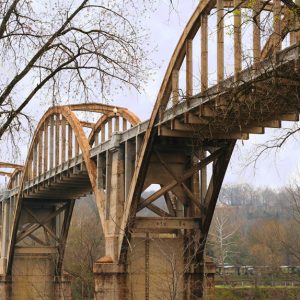 Cotter Bridge
Cotter Bridge 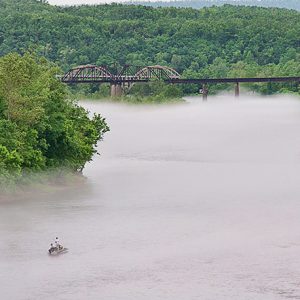 Cotter Bridge
Cotter Bridge 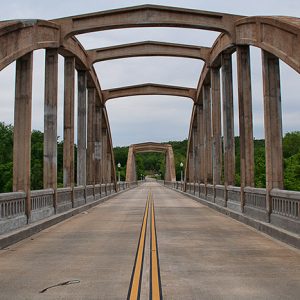 Cotter Bridge
Cotter Bridge 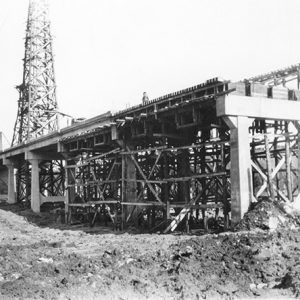 Cotter Bridge Construction
Cotter Bridge Construction 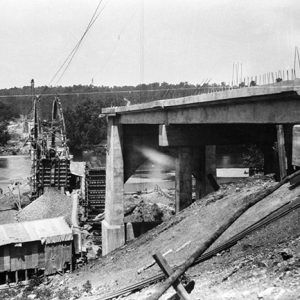 Cotter Bridge Construction
Cotter Bridge Construction 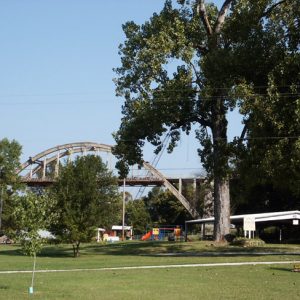 Cottonwood Tree
Cottonwood Tree 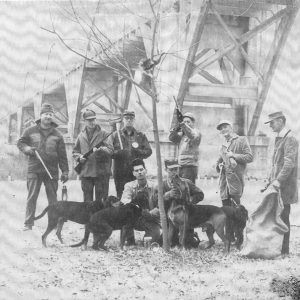 Racoon Hunters
Racoon Hunters 



Comments
No comments on this entry yet.